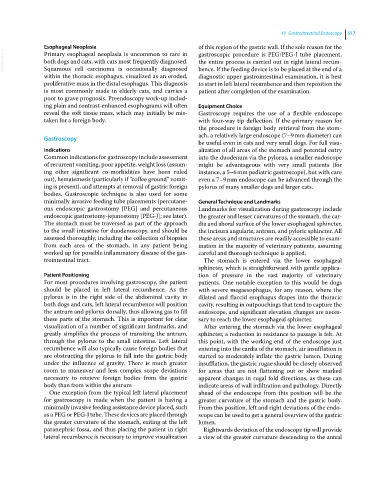Page 549 - Clinical Small Animal Internal Medicine
P. 549
49 Gastrointestinal Endoscopy 517
Esophageal Neoplasia of this region of the gastric wall. If the sole reason for the
VetBooks.ir both dogs and cats, with cats most frequently diagnosed. gastroscopic procedure is PEG/PEG‐J tube placement,
Primary esophageal neoplasia is uncommon to rare in
the entire process is carried out in right lateral recum-
Squamous cell carcinoma is occasionally diagnosed
diagnostic upper gastrointestinal examination, it is best
within the thoracic esophagus, visualized as an eroded, bence. If the feeding device is to be placed at the end of a
proliferative mass in the distal esophagus. This diagnosis to start in left lateral recumbence and then reposition the
is most commonly made in elderly cats, and carries a patient after completion of the examination.
poor to grave prognosis. Preendoscopy work‐up includ-
ing plain and contrast‐enhanced esophograms will often Equipment Choice
reveal the soft tissue mass, which may initially be mis- Gastroscopy requires the use of a flexible endoscope
taken for a foreign body. with four‐way tip deflection. If the primary reason for
the procedure is foreign body retrieval from the stom-
ach, a relatively large endoscope (7–9 mm diameter) can
Gastroscopy
be useful even in cats and very small dogs. For full visu-
Indications alization of all areas of the stomach and potential entry
Common indications for gastroscopy include assessment into the duodenum via the pylorus, a smaller endoscope
of recurrent vomiting, poor appetite, weight loss (assum- might be advantageous with very small patients (for
ing other significant co‐morbidities have been ruled instance, a 5–6 mm pediatric gastroscope), but with care
out), hematemesis (particularly if “coffee ground” vomit- even a 7–9 mm endoscope can be advanced through the
ing is present), and attempts at removal of gastric foreign pylorus of many smaller dogs and larger cats.
bodies. Gastroscopic technique is also used for some
minimally invasive feeding tube placements (percutane- General Technique and Landmarks
ous endoscopic gastrostomy [PEG] and percutaneous Landmarks for visualization during gastroscopy include
endoscopic gastrostomy‐jejunostomy [PEG‐J]; see later). the greater and lesser curvatures of the stomach, the car-
The stomach must be traversed as part of the approach dia and aboral surface of the lower esophageal sphincter,
to the small intestine for duodenoscopy, and should be the incisura angularis, antrum, and pyloric sphincter. All
assessed thoroughly, including the collection of biopsies these areas and structures are readily accessible to exam-
from each area of the stomach, in any patient being ination in the majority of veterinary patients, assuming
worked up for possible inflammatory disease of the gas- careful and thorough technique is applied.
trointestinal tract. The stomach is entered via the lower esophageal
sphincter, which is straightforward with gentle applica-
Patient Positioning tion of pressure in the vast majority of veterinary
For most procedures involving gastroscopy, the patient patients. One notable exception to this would be dogs
should be placed in left lateral recumbence. As the with severe megaesophagus, for any reason, where the
pylorus is in the right side of the abdominal cavity in dilated and flaccid esophagus drapes into the thoracic
both dogs and cats, left lateral recumbence will position cavity, resulting in outpouchings that tend to capture the
the antrum and pylorus dorsally, thus allowing gas to fill endoscope, and significant elevation changes are neces-
these parts of the stomach. This is important for clear sary to reach the lower esophageal sphincter.
visualization of a number of significant landmarks, and After entering the stomach via the lower esophageal
greatly simplifies the process of transiting the antrum, sphincter, a reduction in resistance to passage is felt. At
through the pylorus to the small intestine. Left lateral this point, with the working end of the endoscope just
recumbence will also typically cause foreign bodies that entering into the cardia of the stomach, air insufflation is
are obstructing the pylorus to fall into the gastric body started to moderately inflate the gastric lumen. During
under the influence of gravity. There is much greater insufflation, the gastric rugae should be closely observed
room to maneuver and less complex scope deviations for areas that are not flattening out or show marked
necessary to retrieve foreign bodies from the gastric apparent changes in rugal fold directions, as these can
body than from within the antrum indicate areas of wall infiltration and pathology. Directly
One exception from the typical left lateral placement ahead of the endoscope from this position will be the
for gastroscopy is made when the patient is having a greater curvature of the stomach and the gastric body.
minimally invasive feeding assistance device placed, such From this position, left and right deviations of the endo-
as a PEG or PEG‐J tube. These devices are placed through scope can be used to get a general overview of the gastric
the greater curvature of the stomach, exiting at the left lumen.
paranephric fossa, and thus placing the patient in right Rightwards deviation of the endoscope tip will provide
lateral recumbence is necessary to improve visualization a view of the greater curvature descending to the antral

